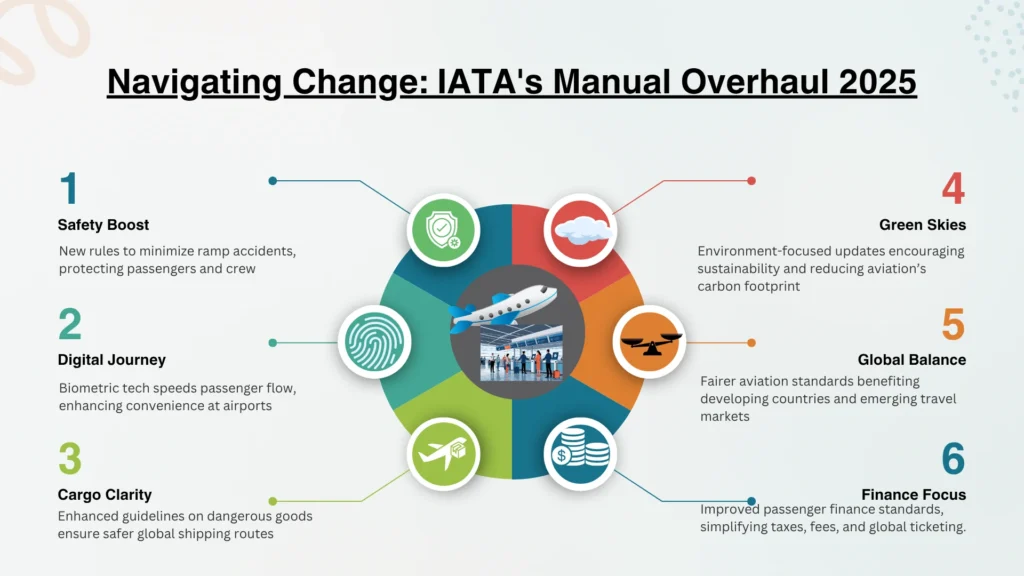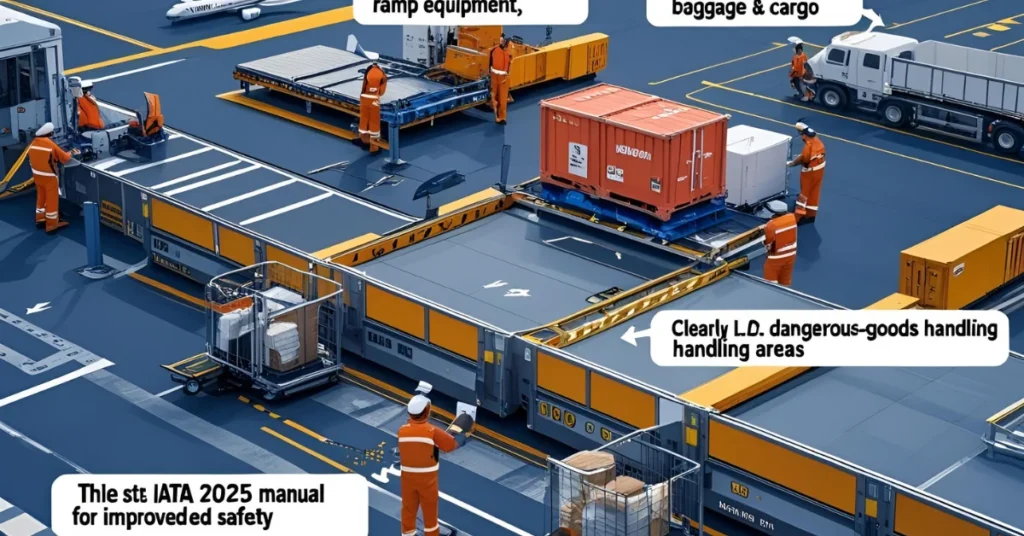Read the key IATA manual updates 2025, boosting aviation safety, streamlining passenger experience, and enhancing global air-travel standards.
On June 11, 2025, the International Air Transport Association (IATA) announced major updates to its key manuals that will change the future of flying.
These changes focus on passenger finance, safety, ground operations, cargo, and security, with more than 350 updates.
They aim to address new threats, such as dangers from lithium and sodium-ion batteries and unruly passengers. These updates will also help make air travel more contactless, sustainable, and inclusive for people around the world.
IATA Manual Updates 2025: Why these updates matter—now
- Innovation takes center stage: IATA’s annual manual update is not merely a matter of routine; it sends a strategic message. These revisions embody industry lessons learned, advancements in regulatory technology, and evolving traveler expectations. They contribute to a worldwide push towards digitalization, safety, and sustainability.
- Passenger protection aligns with finance modernization. While the changes to the finance and taxation manual may not attract as much media attention as safety updates, they are crucial. These modifications integrate into ticketing systems, fees, and taxes, impacting travelers from São Paulo to Nairobi and Chennai alike.
Safety First: Tech‑Fueled Ground‑Handling Evolution
Ground Operations Manual (IGOM) introduces:
| Issue | New Standard |
| Ramp accidents | Ramp accidents refer to incidents that occur on the ramp area of an airport, which can include various operational mishaps. This category of accidents includes fatality data collected through the International Air Transport Association’s (IATA) Incident Data Exchange (IDX) and Aviation Data Exchange (ADX) systems, providing a comprehensive overview of safety concerns within airport operations. |
| Pushback protocols | This document outlines enhanced procedures to ensure safety and efficiency during aircraft pushback operations. Key components include the establishment of no-touch zones around the aircraft, which help minimize unnecessary contact and potential hazards. Additionally, mandatory brake checks are now required to confirm that all brakes are fully operational before initiating the pushback process. These measures aim to enhance overall safety and operational effectiveness. |
| Heavy parts handling | It is essential to implement proper procedures for the safe and efficient management of heavy aircraft components. |
| Weight & balance | The implementation of IATA’s X565 standard, along with the use of ELIR messaging, aims to minimize errors in weight and balance procedures. This adoption enhances accuracy and efficiency in operations. |
Monika Mejstrikova, IATA Director of Ground Operations, stated: “The greater the amount of data we share, the safer our operations become.”
She highlighted that 98 ground fleets have adopted sensor-equipped “Enhanced GSE,” which helps prevent ramp accidents. This trend will be mandated starting April 2025 at ISAGO-accredited airports.

Airport Handling Manual: Contactless Travel & Global Standards
Airport Handling Manual (AHM) key changes:
- Contactless passenger flow:The implementation of contactless passenger flow through biometric IDs and advanced digital admissibility is designed to minimize friction within the airport environment.
- Unruly passenger policy: To address disruptions caused by unruly passengers, ground crews are now equipped with improved tools to intervene early, which helps prevent potential issues before they escalate.
- Cargo handling: In terms of cargo handling, AHM has mandated the digital tracking of perishable goods and live animals by LAR guidelines, as well as special baggage, including engines and mail.
- Emergency alignment: In emergencies, updates are now synchronized with the latest emergency response guidelines set forth by ICAO, ensuring timely and effective response measures.
- Environmental oversight: Furthermore, the integration of IEnvA protocols promotes environmental oversight by encouraging the adoption of green practices across the industry.
African and Middle Eastern airports, often overlooked, will now benefit from enhanced digital identity systems and improved policies regarding passenger behavior. This will create a more equitable global environment.
Dangerous Goods & Battery Shipping: A Surge in Hazard Management
Dangerous Goods Regulations (DGR) – 66th edition; Battery Shipping Regulations (BSR) – unified battery rules :
Recent updates in the field of batteries and hazardous materials include several key developments:
- New chemical entries: This category covers the inclusion of sodium-ion batteries, both existing and emerging battery-powered vehicles, along with revisions to UN-code assignments and the “BATTERY” mark.
- Battery consolidation: Regulations concerning lithium, nickel-metal hydride (NiMH), and sodium-ion batteries have been unified. Additionally, the Class-9 hazard label has been updated to reflect these changes
- Digital airway bill requirement: Starting January 1, 2025, a new mandate will require a reference to a dangerous-goods declaration on digital airway bills.

Security Manual Update: Risk‑Based Resilience
The 2025 Security Management System (SeMS) manual enhances risk assessment capabilities with several key updates.
- Firstly, the documentation section has been reorganized to improve clarity regarding compliance requirements.
- Secondly, the flow of incident reporting has been enhanced to facilitate better communication between airlines, ground staff, and regulatory authorities.
- Additionally, new monitoring tools have been introduced, including a SeMS dashboard and a certification path.
These advancements in risk-based, auditable security measures are crucial as global air travel continues to recover from the pandemic. This is important in light of emerging threats such as drones, cyberattacks, and disruptive behaviors at airports.
IATA Manual Updates 2025 -Bigger Picture: Trendlines & Tactics
- Digital-First and Globally Inclusive: Travel is becoming seamless, moving from doorstep to cockpit. Tools like digital admissibility and baggage tracking are not just advantages in Europe or the U.S.; they are essential resources becoming prevalent in Asia, Africa, and Latin America.
- Safety Through Data Sharing: Ramp statistics, battery guidelines, and live animal handling indicate a significant shift towards collaborative risk reduction.
- Cross-Manual Integration: Security, environmental concerns, and passenger finance are interconnected within IATA’s digital ecosystem, signaling a comprehensive transformation rather than isolated improvements.
What This Means for Passengers & Operators
- Passengers: Enjoy safer and smoother journeys with less document hassle, fewer lost luggage incidents, and clearer regulations regarding batteries.
- Airlines and ground handlers: Must invest in new technologies such as advanced ramp equipment, digital messaging systems, and biometric scanners to avoid non-compliance.
- Regulators, particularly in developing countries, should obtain a blueprint to align national regulations with global standards, facilitating easier trade and travel.
IATA Manual Updates 2025: Looking Ahead
The IATA manual overhaul scheduled for 2025 represents more than just impressive rhetoric; it signifies a significant shift towards progress. In the coming year, we can expect key announcements at the following events:
- -Passenger Terminal Expo 2025: Focused on biometric and contactless technologies.
- – ISAGO Audits: Where enhanced Ground Service Equipment (GSE) and Safety Management System (SeMS) compliance will become mandatory.
- – UN Climate Conferences: Highlighting electrified GSE and environmental tracking as central themes.
- The aviation industry is entering a new phase: transitioning from resilience to reinvention.
In summary, IATA’s 2025 manual overhaul is more than just paper—it’s a roadmap for the future of aviation.
It integrates safety, digital convenience, environmental considerations, and global fairness, paving the way for a new chapter in aviation—connected, aware, and continuously expanding.
Also Read:
Sky Alliance Takes Off: U.S. and Global Regulators Unite on eVTOL Safety

